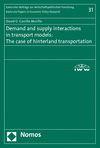Demand and supply interactions in transport models: The case of hinterland transportation
Zusammenfassung
Die Verarbeitungsmenge in der Logistik von Seehäfen bricht jedes Jahr Rekorde. Der Autor untersucht die dynamische Strategie von Logistik-Lieferanten und Unternehmen auf der Suche nach den besten Dienstleistungen, um das langfristige Gleichgewicht zwischen der Verteilung von Kunden und effizienten Standorten von nachhaltigen Lieferanten zu erzielen.
Abstract
Die Verarbeitungsmenge in der Logistik von Seehäfen bricht jedes Jahr Rekorde. Der Autor untersucht die dynamische Strategie von Logistik-Lieferanten und Unternehmen auf der Suche nach den besten Dienstleistungen, um das langfristige Gleichgewicht zwischen der Verteilung von Kunden und effizienten Standorten von nachhaltigen Lieferanten zu erzielen.
- 2–4 Titelei/Inhaltsverzeichnis 2–4
- 5–9 Foreword of the Editor 5–9
- 10–10 List of Figures 10–10
- 11–12 List of Tables 11–12
- 13–14 1 Introduction 13–14
- 13–13 1.1 Motivation 13–13
- 1.2 Overview
- 15–28 2 Globalisation effects on port competition 15–28
- 15–19 2.1 Impacts of globalisation on trade and transport technology 15–19
- 15–16 2.1.1 Removal of trade barriers 15–16
- 16–17 2.1.2 Deregulation of ports 16–17
- 17–19 2.1.3 Transport technology 17–19
- 19–23 2.2 Challenges for the global transport system 19–23
- 19–20 2.2.1 Maritime networks 19–20
- 20–23 2.2.2 New role of ports 20–23
- 23–25 2.3 Emergence of strategical cooperation 23–25
- 23–23 2.3.1 Maritime and port alliances 23–23
- 23–24 2.3.2 Maritime and hinterland interdependencies 23–24
- 24–25 2.3.3 Port and hinterland reciprocity 24–25
- 25–27 2.4 Competition between port-hinterland systems 25–27
- 27–28 2.5 Synopsis 27–28
- 29–42 3 Hinterland transportation analysis 29–42
- 29–30 3.1 Definition and methodological approach 29–30
- 30–33 3.2 Modes of transport and intermodality 30–33
- 30–30 3.2.1 Road 30–30
- 30–31 3.2.2 Railways 30–31
- 31–31 3.2.3 Inland waterways 31–31
- 31–31 3.2.4 Short-sea shipping 31–31
- 31–33 3.2.5 Interoperability 31–33
- 33–38 3.3 Typology of actors 33–38
- 33–34 3.3.1 Generators of demand (shippers) 33–34
- 34–36 3.3.2 Builders of transportation chains 34–36
- 36–37 3.3.3 Infrastructure operators and managers 36–37
- 37–38 3.3.4 Carriers 37–38
- 38–42 3.4 Decision-making process 38–42
- 3.4.1 Demand and supply interactions
- 42–42 3.4.2 Markets’ perception 42–42
- 43–64 4 Modelling the emergence of colloidal structures in hinterland freight transportation 43–64
- 43–45 4.1 The concept of Colloidal Structures 43–45
- 45–52 4.2 Theoretical framework 45–52
- 45–46 4.2.1 Freight modelling considerations 45–46
- 46–49 4.2.2 Economic choices 46–49
- 49–52 4.2.3 Entropy 49–52
- 52–56 4.3 Modelling dynamic economic choices with the master equation 52–56
- 52–55 4.3.1 Equilibrium number of alternatives of the Master equation 52–55
- 55–56 4.3.2 Condition for mesoscopic structural system dynamics 55–56
- 56–59 4.4 Development of a new conceptual approach 56–59
- 56–57 4.4.1 Cohesion between meso-dynamics and Entropy variation 56–57
- 57–59 4.4.2 Free Economic Energy 57–59
- 59–64 4.5 Experimental validation 59–64
- 65–86 5 Extension of the FEE for spatial modelling 65–86
- 65–70 5.1 Distribution notions and problem definition 65–70
- 65–67 5.1.1 Literature review 65–67
- 67–68 5.1.2 Problem statement 67–68
- 68–69 5.1.3 Subcategorisation of demand segments 68–69
- 69–70 5.1.4 Representative demand cell’s function 69–70
- 70–79 5.2 Extension to one dimension 70–79
- 70–71 5.2.1 Linear proportion of fixed costs 70–71
- 71–77 5.2.2 Linear transport cost and location 71–77
- 77–79 5.2.3 Interpolation of distribution demands over one dimension 77–79
- 79–86 5.3 Accession to two dimensions 79–86
- 79–81 5.3.1 Spatial proportion of fixed costs 79–81
- 81–85 5.3.2 Spatial transport cost and position 81–85
- 85–86 5.3.3 Generalised functions over two dimensions 85–86
- 87–104 6 Real Validation and application cases to the German hinterland 87–104
- 87–89 6.1 Data sources 87–89
- 87–87 6.1.1 Description of the inland terminals’ data 87–87
- 87–88 6.1.2 Database overview on the employees per productivity sector 87–88
- 88–88 6.1.3 Aggregated data on export and import trades 88–88
- 88–89 6.1.4 Database on the production per sector in Germany 88–89
- 89–89 6.1.5 Regional data at a district level 89–89
- 89–94 6.2 Processing of databases 89–94
- 89–92 6.2.1 Distance between clusters 89–92
- 92–94 6.2.2 Industrial density 92–94
- 94–104 6.3 Real case validation of the spatial FEE extension 94–104
- 94–98 6.3.1 Data adjustments 94–98
- 98–102 6.3.2 Assessment of Policy Strategies to develop Intermodal Services 98–102
- 102–104 6.3.3 Spatial policy assesment in intermodal offers 102–104
- 105–110 7 Conclusion 105–110
- 111–114 A Selection of the builder 111–114
- 111–113 A.1 Subcontracting 111–113
- 113–114 A.2 Contracts 113–114
- 115–117 B Market segments influencing colloidal structures 115–117
- 115–116 B.1 Door-to-door vs. Just-in-time deliveries 115–116
- 116–117 B.2 Carrier vs. Merchant haulage 116–117
- 118–119 C Alternative Classical deduction of the Equilibrium 118–119
- 120–122 D Integral solution 120–122
- 123–129 Bibliography 123–129


